#Filipino Tribe
Explore tagged Tumblr posts
Text
Tribal Headhunters On Coney Island? Author Revisits Disturbing American Tale! New Book Examines Troubled History of Filipino Tribe Brought To America In 1905.
— Published: October 28, 2014 | By Linda Qiu | Friday May 31, 2024
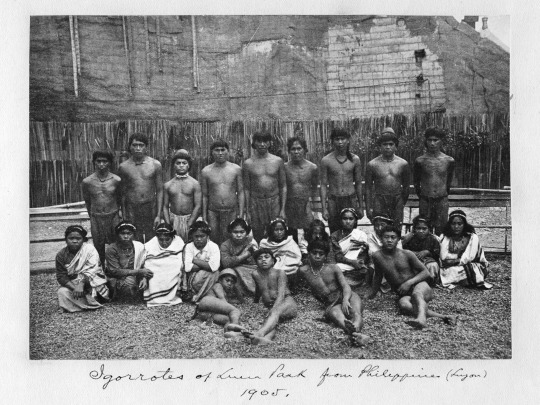
These Igorrotes were paid $15 a month to demonstrate their culture and customs at an amusement park on Coney Island in 1905. Photograph Courtesy of Claire Prentice
Transplanted from the Philippines to New York's famous Coney Island Amusement Park in 1905, a band of Igorrote (Igorot) Headhunters went on to tour the United States, performing mock tribal ceremonies and consuming dog meat for millions of curious and horrified Americans.
But, once a national sensation, the Igorrotes—and the doctor arrested for exploiting them—have been largely forgotten, writes Journalist Claire Prentice in her new book, The Lost Tribe of Coney Island: Headhunters, Luna Park, and the Man Who Pulled Off the Spectacle of the Century.
National Geographic recently discussed with Prentice how she pieced together the group's turn-of-the-century odyssey and how some of the forces that brought the Igorrotes to America and obscured the truth about them may still be in play today.
How did you discover the story of the Igorrotes?
I had been living in New York and working as a journalist. I had a fascination with 1900s Coney Island and took trips there often. One day, I saw these pictures of the Igorrotes tattooed, in G-strings and, well, not very much else. The energy of the photos drew me in and captivated me.
I researched through big institutions like the National Archives [and] the National Library of the Philippines, and smaller places like the Bontoc Municipal Library in the Philippines's Mountain Province. I found declassified [U.S.] government files, vital records, and newspaper articles that hadn't been read for a hundred years. So I read about the terrible things these people suffered at the hands of a man they had trusted, someone who they thought was a protector in a strange land, and who had treated them abominably.
So let's talk about the man who brought them here. Who was Dr. Truman Hunt?
Truman Hunt went to the Philippines at the outbreak of the 1898 Spanish-American War. He was trained as a medical doctor, and he stayed on in the country after the war ended. He was later made lieutenant governor of Bontoc, where the Igorrotes lived, and got to know them well.
In 1904, the American government spent $1.5 million taking 1,300 Filipinos from a dozen different tribes to the St. Louis Exposition as part of a scheme intended to drum up widespread popular support for America's policies in the Philippines by demonstrating that the people of the islands were far from ready for self-government. Truman Hunt was made the manager of the Igorrote Village, which drew the largest crowds of all in the Philippine [part of the fair].
The enormous popularity of the Igorrotes gave Hunt the idea to return to Bontoc and gather another Igorrote group. He offered $15 a month to each Igorrote who volunteered to go to America with him and put on a show of their culture and customs. He planned to begin their tour at Coney Island and then move on to other amusement parks across the country.
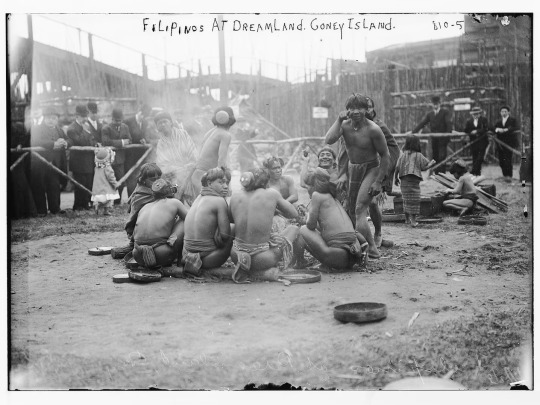
Visitors observe the Igorrotes living at Coney Island in 1905. Photograph Courtesy of Claire Prentice
You write that Truman Hunt was the mouthpiece for Igorrotes and the press just reprinted a lot of his tales. How difficult was it to find out what really happened?
To begin with, as a journalist, I didn't entirely swallow the news stories, though Hunt knew how to spin a story. By the time I got the key bits of the story and read the government files about his wrongdoings, it was clear just how distorted the picture was and how spun it really was.
Some of the "factual" stuff was entirely made up. In the newspapers, Truman talks about one particular incident: a huge fight between the Igorrotes and the white residents of Coney Island that ends up with the two groups fighting and grabbing pitchforks. He presents this whole scene of a savage battle, and it was entirely made up. In another one, he set up the theft of a dog—he had someone bring in a dog, unleash it, and told the Igorrotes to chase it. But the newspapers printed it as the Igorrotes were savage and wanted to steal this dog.
This was a time when human zoos were something of a trend. Ethnic peoples were exhibited in similar spectacles from Paris to Tokyo. What was special about the Igorrotes?
They were hardly in clothes. Their bodies had tattoos all over them. They had hunted heads in their home—and the dogs. Dogs were brought from the New York pound, chopped up, and put in a pot, and then people watched the Igorrotes eat the stew. This behavior scandalized Americans but also captured their imagination.
But the zoo quickly came to be seen as shameful, and something Americans didn't want to remember, that people were exhibited in this manner, so it was forgotten. There were other examples where people were coerced, cultures were distorted, but in this case, the U.S. government had given permission to exploit these people.They were directly involved.
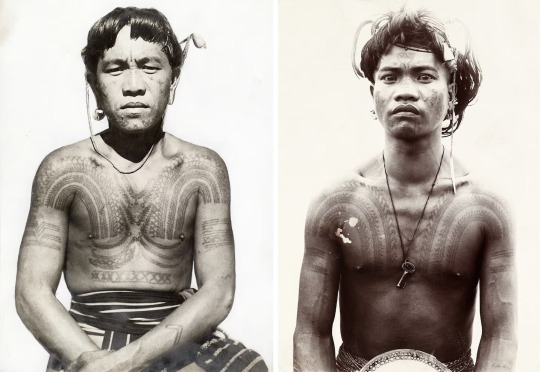
Igorrote men, like these photographed in 1912, often had multiple tattoos and wore little clothing. Photograph Courtesy of Claire Prentice
How did the presence of America in the Philippines in the 1900s factor into the Igorrotes' situation?
The U.S. backed the exhibition as a way to support their political goal of maintaining control over Philippine territory, by demonstrating that the Philippine people were far from ready for self-government.
Coverage of the Igorrotes was in the newspapers, daily. People were talking about it. It was very controversial and very topical, and people were reading about and had an interest in it. The fact that they were from the Philippines was definitely another layer of attraction.
But I don't think Truman Hunt was trying to champion that cause. He was doing this out of his own interests. He was very charming, very opportunistic.
In your epigraph, Hunt is quoted in a newspaper saying, "I was healer of their bodies, father confessor of all their woes and troubles, and the final arbiter in all disputed questions," yet he basically put the Igorrotes in the zoos. Do you think he cared for these people?
That's something I thought long and hard about. Before he brought them to America, he did volunteer to work in a cholera hospital in Luzon. He genuinely did risk his life for his Filipino patients. The Truman Hunt at the end of the book wouldn't have done that. I think he became very, very badly corrupted. They were objectified so much, gawked at daily, that I think he came to regard them distantly and as a commodity.
The question of authenticity comes up a lot in the book—the authenticity of the record as well as the authenticity of the display of the Igorrotes themselves.
I don't think the display can really be considered authentic. The traditional ceremonies performed before head hunts and the other tribal dances—those were generally rare in real Igorrote life. Same with the eating of dogs. These things were ceremonial and so definitely didn't occur every day. But Truman wasn't bothered by authenticity. They were there to add a sense of drama to the show.
It seems abominable to us now that people were looking at these human zoos. But back then people went to ‘attractions’ like the Igorrote Village in the same way that they go to the movies today. They took their families. At the time it was mainstream entertainment.
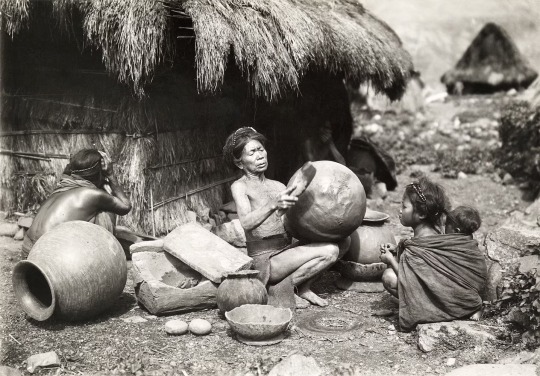
An Igorrote potter is shown surrounded by her clay wares and other tribe members in 1912. Photograph Courtesy of Claire Prentice
You write that these zoos fulfilled a need for sensation and an ethnological obsession. Those needs don't seem unique to the 1900s. I kept thinking about reality television.
We have certainly a variation on that today, [with] wealthy Western tourists traveling to see authentic shows of ethnic peoples in Africa and Asia. It's a commodity. And absolutely, some of the TV shows today—you know, Beauty and the Beast types—are just awful. It's obviously deep within human beings to want to look at people different from themselves. That's just a fact.
There is a shred of justice administered at the end of the book. Truman Hunt is arrested. How did that happen?
The U.S. government's Bureau of Insular Affairs, which [was] part of the War Department, received a tip that Hunt was not taking adequate care of the Igorrotes. There were other rumors that he had stolen their wages and that two men in the group had died on the road and that he had failed to have their bodies buried.
The government sent an agent to investigate the claims, and Hunt went on the run, taking a group of Igorrotes with him. The Pinkerton Detective Agency was hired to help track him down. Eventually, he was accused of embezzling around $10,000 in wages from the Igorrotes and of using physical force to steal hundreds of dollars more that they had earned selling handmade souvenirs.
Finally, after a manhunt across the U.S. and Canada, the government arrested him in October 1906. He was sentenced to 18 months in the workhouse after an incredible trial in Memphis.
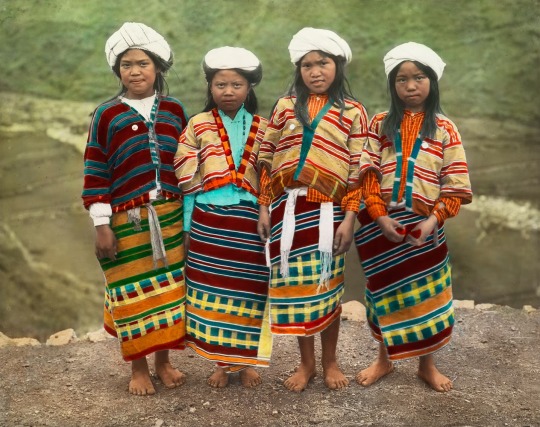
Four Igorrote girls pose for a hand-tinted portrait in Luzon, Philippines, in 1913. Photograph Courtesy of Claire Prentice
After Truman Hunt's arrest, what happened to the Igorrotes?
In late July 1906, a couple of months after their contracts with Hunt expired, the government stepped in and sent home all of the Filipinos—except five who stayed on as witnesses in Hunt's trial. The court cases dragged on. Five Filipino witnesses were kept in America until March 1907. On March 20, they too returned to the Philippines.
It has been difficult to discover a great deal about their lives after they returned to the Philippines because a huge volume of the Philippines's vital records were destroyed during WWII. I have pieced together what I have been able to find and have included this in the Afterword. I hope that this book will lead to further discoveries about their later lives.
— This interview has been edited and condensed.
#Coney Island#Coney Island Amusement Park#Tribal Headhunters#Revisits#Disturbing | American Tale#Troubled History#Filipino Tribe
0 notes
Text
with all the adaptations there have been of ghosts either out now or announced, I've been really thinking about the possibility of ghosts philippines on like gma or the kapamilya channel or something maybe. so I did some conceptualizing. here's part 1 of the ghosts ph hypothetical cast!!!

for some clarity's sake:
thomas / captain (?) / isaac (?) counterpart: sol
lady of the house (fanny/hetty) counterpart: lumeng
pat/pete counterpart: ena
if you have any suggestions for who else to add, please reply or smth!!! I'm a bit stumped, though I have a few ideas.
#i'm thinking of maybe a ghost from the martial law era#someone resembling an aswang from maybe any era really#like how lumeng resembles a white lady in filipino myth#and maybe an indigenous filipino ghost?#but i havent really decided where the salvador estate would be so#idk which tribe theyd be from#ghosts cbs#ghosts bbc#ghosts uk#ghosts us#ghosts ph#i guess!!!!#my art
22 notes
·
View notes
Text
Indigenous tribes of the Philippines and cultural appropriation
There are one hundred and ten (110) major Indigenous groups in the Philippines. If you think you can just pick and choose beliefs from groups to suit you and you are NOT a part of those indigenous groups, you are straight up appropriating our culture. Most tribes that have survived, do not have legal recognition over their own traditional lands or have access to natural resources in their communities. The last thing they need is for some misinformed entitled non-native born bastardising their cultural beliefs and practices. Reconnecting involves staying in your lane and respecting that some things are just not for you. I appreciate and thoroughly enjoy reading about other tribes and what they do, but if it's not a Tagalog or Ilokano custom, belief or practice - they are not for me. Bahala na talaga (Reposted from birb app 🐤)
#Indigenous Filipino Tribes#Ilokano#Tagalog#pre colonial philippines#filipino culture#pinoy culture#filipino witch#filipino witchblr#filipino witches#pinoy witch#pinoy witches#pinoy witchblr#witchcraft#my tweets
62 notes
·
View notes
Text
Happy Philippine–Spanish Friendship Day
Feliz día de la Amistad Hispano-Filipina (con retraso)
Allow me to share some pseudo-colonial painting because I don't care, it is super pretty. Plus, I can't decide which of the two versions I prefer. Maybe the Roman looking one, because I'm a sucker for Rome XD
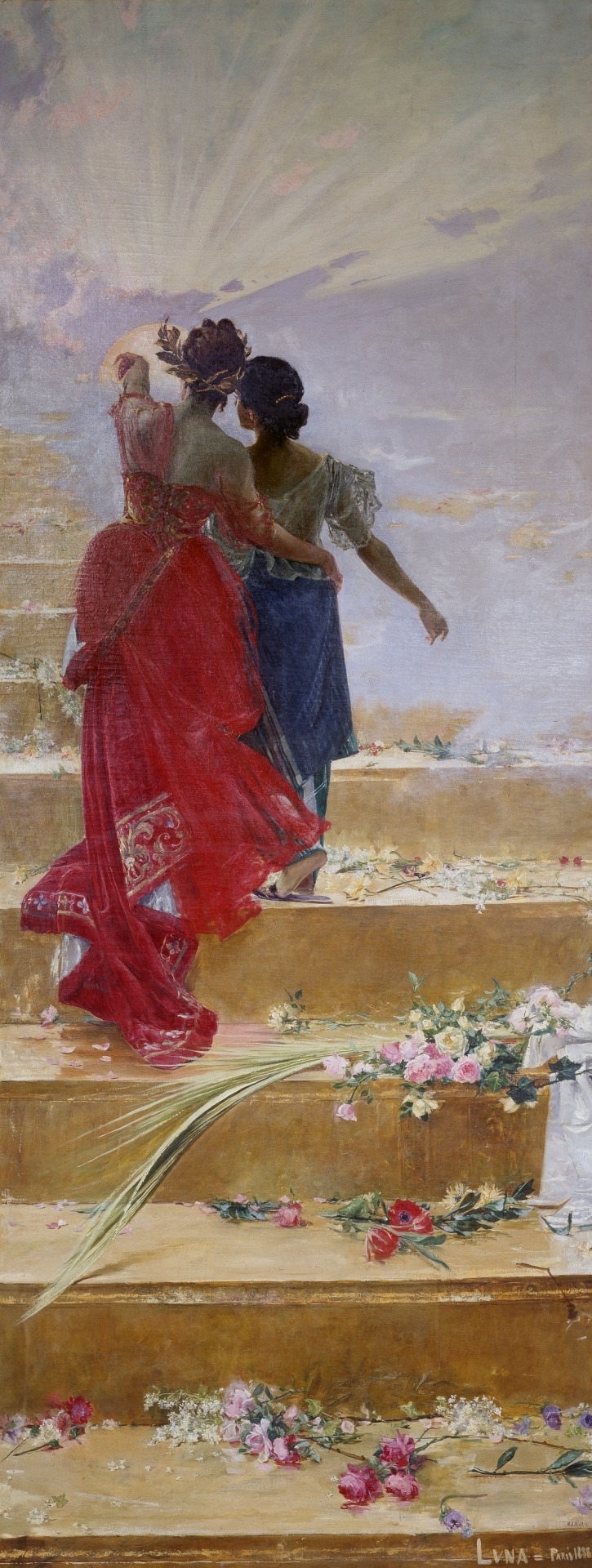

España y Filipinas (Spain and the Philippines)
Also known as España llevando a la gloria a Filipinas ("Spain Insuring the Glory of the Philippines") or España Guiando a Filipinas ("Spain Leading the Philippines"), by painter Juán Luna.
#philippines#art#filipino art#painting#spain#españa#filipinas#also#nice water tribe fire nation aesthetics#fucking live action has me obsessed#i find it kinda funny that the guy who voices zuko is filipino#and now in the love action it is aang who gets to be played by a filipino actor#lol#those two#i love them#specially zuko#sorry aang#netflix is going to mees it up good though#so sorry for the actors but i'm a natural pessimist and so far the only thing they got kinda right were the ethnicities#i went completely out of topic XD
27 notes
·
View notes
Text

Hi, Filipino here. Our traditional attire does not look like this nor does the music for Tinikling sound like that. I grew up doing cultural performances of many Filipino traditional dances, including Tinikling, and this is NOT Tinikling. Shoutout to @mindsey-moonbow whose comment is probably going unnoticed in the notes.
#malaysia#malaysian culture#Magunatip#malay traditional dance#murut people#now i may not be the most ''filipino'' filipino around. i am only half but i grew up in the country and and learned as much as i could#about my ancestors. my mother's province and the other tribes of this country. and i have never seen this in my life#even the Ifugao and the Igorot don't look like this. yes we do have feather headdresses but not like this#i saw video and thought wow that's similar to tinikiling but it's not then i saw the comment and thought no... that's NOT tinikling#went to the notes to see if anyone corrected and and lo and behold i had to scroll to far to find out it was Malaysian#yes there are a lot of similarities between many SEA countries. but just because they're similar doesn't mean they're the same#oh and if you're tagging this Native American... for shame
77K notes
·
View notes
Text

miku as my babaylan oc who is trans
babaylan research dump (mostly from memory so it’s gonna be pretty distilled):
babaylans are the lead shamans of indigenous filipino tribes (mostly northside, the luzon and visayas area, rip mindanao) that are responsible for practically every spiritual aspect of the community. only women were allowed to be babaylans, since, according to local mythos, women had more affinity to the spiritual realm.
however, what i find notable about babaylans is that their requirements also include transgender women! one does not simply choose to become a babaylan, instead, she has to train under a senior and go through a ritual before the anito (local spirits) deemed her worthy of representing them. the only exception is if a girl went through something that confirmed to the people immediately that she had anito approval. notably, trans women were also among the subset of girls who got to skip the selection process. this is my speculation but i like to think it’s probably because the locals considered the realisation that one was trans as anito approval. assigned female by duende
usually, i’m very wary of putting modern queer labels onto historical figures (we don’t know how they would identify now), but spanish colonial records noted that amab babaylans, outside of their ritualistic roles, would live like women (down to having husbands), were treated like women and were simply considered women barring the ability to bear children. if she walks like a woman, talks like woman…that didn’t stop the spanish settlers from misgendering them, though.
that being said, in present day, while there are still people out there practising babaylan rituals, they’re mostly men who only take on feminine appearances during the rituals, and live as men in their regular lives. this stems back from the spanish colonial period and we are not getting into that now this read more is long enougb as it is
personally i find this fascinating because, at least for what i was able to look into, trans babaylans were the only time i could look at a historical indigenous gender identity and definitively refer to them as lgbt. most other indigenous identities are either meant to be their own thing (not native american, but i remember reading discourse over whether two-spirit should be considered nb or as its own thing) or far too complex to be described with the western modern lgbt terms (although they generally present feminine, the hijras from india classify themselves as a separate third gender and worship specific deities from hinduism). maybe i haven’t looked hard enough but it’s so interesting to hear about old communities where women, and especially trans women, were basically the most important figures
anyway sorry for rambling. sometimes i like to ramble.
556 notes
·
View notes
Text
as someone who has recently read the reckoning of roku, it’s really not the anti fire nation propaganda that a certain subsection of fandom is making it out to be. yes, gyatso says those words to roku, but he’s angry - at both the world and at himself for the death of his sister. he later apologizes to roku. the book does not paint gyatso out to be in the right, and neither does it paint all fire nation citizens to be in the wrong. the narrative even makes a distinction between the good fire nation citizens (ta min and roku) and prejudicial fire nation citizens (sozin, primarily), and some morally ambiguous ones like dalisay, but they’re more or less abolished from any accountability for partnering with sozin.
avatar the last airbender does not do a good job at displaying much of the context associated with the crimes of the fire nation, aka the climate and perspectives that justified sozin eradicating the air nomads and many of the benders in the southern water tribe. we know from avatar that sozin wanted to conquer the rest of the world for fire nation domination and expansion, but we’re not given much insight into the causal factors that allowed him to conduct genocide and colonialism, beyond “he was able to do it all in one day with the power of the comet,” and “he was a very bad man.”
the reckoning of roku provides the context for all of that, the factors that contributed to sozin’s blood-thirst. which means seeing sentiment from sozin that view the air nomads - and their pacifist ways of life - as inferior and below human. the novel doesn’t particularly attempt to humanize sozin, not in the way that other medias do when exploring the backstory of their villain. at the end, the takeaway from the novel is that sozin is on the road to becoming the ultimate fascist we all know him for, but this time we’re provided more context into how he became that fascist, and why roku hesitated to kill him.
is it more critical of the fire nation than most of the franchise? yes, i would say so, and having a filipino author be the one to offer that commentary is an excellent decision by avatar studios. but the extent of the critique is still more or less along the lines of “this one guy was truly the operations behind it,” which is still consistent with what we’ve seen in atla. there’s nothing too radical introduced in terms of colonial theory, unlike what parts of the fandom are saying.
which leads me to my final point: if this is how badly a subsection of fandom (aka fire nation worshippers and zutara shippers [not mutually exclusive]) are reacting to the simple notion exploring how sozin committed genocide, then they’ve hit further rock bottom than i can imagine. not only that, but this type of reactionary behaviour risks alienating other parts of the fandom; for instance, fans of the avatar novels who otherwise would have given the ship and the shippers grace.
in other words, many of these hardcore shippers “criticizing” the roku novel have no one to blame but themselves if their behaviour leads to the alienation of regular fans. this loud subsection of fandom is so caught up in their one-sided, imaginary fantasy where everything in the franchise somehow revolves around aang/kataang vs zuko/zutara, that the Evil Bryke are always targeting them, to the point that they’ll fail to realize that the fire nation and fire nation characters are often absolved from accountability across the IP, and the fire nation is explored much more than the other nations are.
#some of yall had me perceive the roku novel as this ultimate commentary and critique of the fire nation#so imagine my disappointment when it wasn’t#still a good read though i recommend#And ribay is a great author#antizutara#reckoning of roku
109 notes
·
View notes
Note
hello! i saw your post from a while ago about race and casting in the musical, and i was wondering if you'd be willing to share some more thoughts on it? i'm working on my honors thesis and the idea seems really compelling :)
man i don’t even know what post this ask is about because i feel like i talk about this All The Time but of COURSE i will yap more! i mean just like on a basic level the Socs being cast as generally white/white-passing and the greasers being cast as multi-ethnic is such a fantastic choice that just adds another layer to the class dynamics of the story!! I absolutely adore the choice to only cast actors of color in the roles of Johnny and Dally and think it adds so so much to their characters <3 Dally being portrayed as a Black man is so intentional and adds something to the way he’s developed this tough-guy persona to avoid being hurt… and specifically Johnny being Native American is such a special choice in my opinion especially with the story taking place in Oklahoma and Johnny always having been described as darker-skinned… and also the way the greasers are able to show their race/heritage in their costumes is so so special… the embroidery on Sky’s jean jacket that represents his tribe, the Black power patches on Renni’s jean jacket, the sheer visibility of Daryl’s tattoo…
If you follow me it’s obvious that i think about this most often with reference to Ryo Kamibayashi covering four of the Soc boy tracks (Paul, Chet, Brill & Trip) because god this musical is so intentional with its casting in terms of race and the choice to have an Asian American man be the first visibly non-white actor to portray a Soc is so fascinating… like there is intrinsically SO much there about the myth of the model minority and like. something about how the west side of Tulsa as it is presented in this narrative as this seemingly all-american dream of suburbia and how that is affected by the presence of an Asian family… how that family is affected by their overwhelmingly white setting… the way that the rise of suburbia after World War II broadened the definition of whiteness to include Irish/Italian/Jewish/Catholic minorities so that it could stand even stronger in opposition to Blackness & where an Asian family would fit into that binary… and of course speaking of World War II, casting a Japanese American actor in any of the Soc boy roles sends the implicit message that this character’s parents were incarcerated in concentration camps by the American government a little over 20 years before The Outsiders takes place and raises the inherent question of how they got from there to this successful life on the rich white side of town. I also think it’s so purposeful that out of the three actors in the cast who have Asian heritage — Daryl Tofa is Filipino/Samoan and Jordan Chin is I think half-Chinese (not 100% sure but basing this off of his last name and the Hong Kong flag in his Instagram bio) — Ryo is both the one with the lightest skin and the only one who covers any of the Soc tracks. Something about the way his Soc character is an example of the myth of the model minority but then how that casting choice connects to all of the white-passing actors who portray Socs in the show — Victor, Henry, and Anna are Hispanic and Cameron is biracial. Cameron actually dropped some lore on a Soc Saturday a couple months ago about how his Soc boy character’s (white) mom fell in love with a (Black) greaser so she got sent out of Tulsa and he got adopted by his (white) grandparents… but then also there’s a bit in one of the Call Me Cherry vlogs where Henry is talking about his favorite costume details and mentions that when he’s playing a greaser he’s allowed to show his heritage through his costume (implying that when he plays a Soc he is not allowed to)… but just thinking about the way all of these nonwhite Soc characters have to stay so distant from their race/heritage because they are Socs… the way class and race are so intertwined even in just the casting of these roles…
this is long and messy and incoherent but if you are interested in more of these thoughts from me you can check my “japanese american paul holden” tag. thanks so much for the ask!!
#the outsiders#the outsiders musical#the outsiders broadway#ryo kamibayashi#sky lakota lynch#renni anthony magee#daryl tofa#jordan chin#victor carrillo tracey#anna k bermudez#henry julian gendron#cameron burke#japanese american paul holden
20 notes
·
View notes
Text
Thank you so much about clarifying about the honorary names and clothes! It honestly warms my heart a bit to know that it seems a good amount of research was done to make the comic run respectful to the tribe.

Also @ your tags please overshare would love to hear your thoughts!
Sometimes I see reviews about D&W where people think Worst Wolverine's backstory is super lacking. That they expected something epic like how Mysterio tricked Logan to slaughter everyone in the Old Man comic run.
But that plot, at least to me, doesn't make The Worst Wolverine. It probably makes the Most Tortured Wolverine -- the story of a man slaughtering his own family with his bare hands because he was mind controlled. Which inevitably created a power vacuum so gigantic that the world basically collapsed as supervillains take over the world.
But the title of Worst Wolverine should belong to the Logan that completely abandons his most important moral value: to be the protector.
Sure, he tends to be nomadic and at times self-isolates, but at his core he truly knows what it means to be a pack animal: to be a part of a cohesive family unit, rely on others, be a guardian for the weak.
In a literal sense, a common backstory for him was that he just fucked off from human society after he mutated to live with a pack of wolves. He turned feral, but they also taught him about the importance of community.
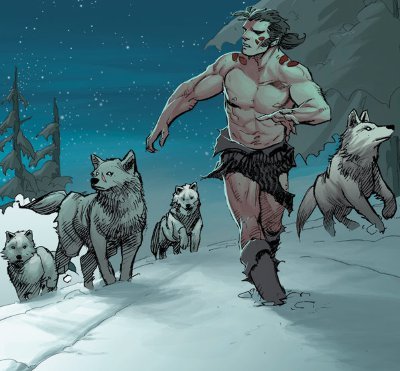
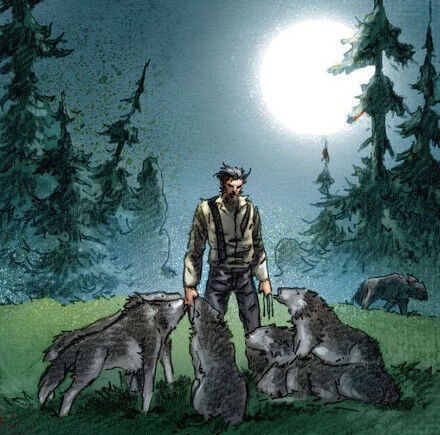
Even if you aren't a fan of the wolf background (which I AM because I think it's funny and dramatic as hell), there's other stories where he got taken care of by the Blackfoot Tribe and Lord Ogun before somehow winding up in the Weapon-X Program. Then, the Hudson family rescued him and helped him gain his humanity back after the adamantium experiments. He joined Department H, and sometime after, he found his place with the X-Men.
My point being that past or present, Logan has always belonged to a family. He needs it -- his human AND animal side both need it. He's not meant to be a creature of solitude. When he is, it's a form of punishment that he inflicts upon himself because he doesn't feel worthy to be around the people he loves or he's worried about hurting the. Or it's something inflicted upon him -- aka he's been captured and is being experimented on.
So what does all this tell us about Logan's moral code? He cares deeply for others because it's in his nature to be a part of a pack and he will do anything to protect them.
He's very caring towards animals (ex. looking after wolves that took care of him, mercy killing a bear in The Wolverine, and saving the horses in Logan). He tried to save Silver Fox's life when Sabretooth attacked her. When his wife Itsu was murdered, he relied on the advice of Lord Ogun to get the vengeance for her with the Muramasa Blade. He joined Department H and Alpha Flight because he owed the Hudsons so much after re-acclimating him to society. He stayed with the X-Men because Charles gave him a home, family, and purpose outside of being a weapon. He enabled him to be the good man that he is by not only using his powers for the good fight but also being a teacher for the students.
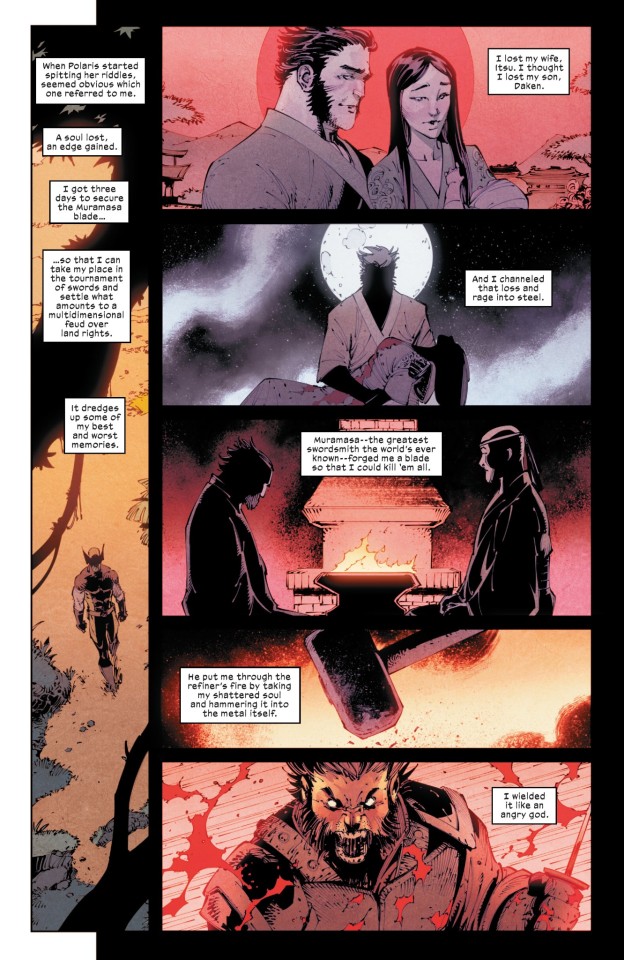
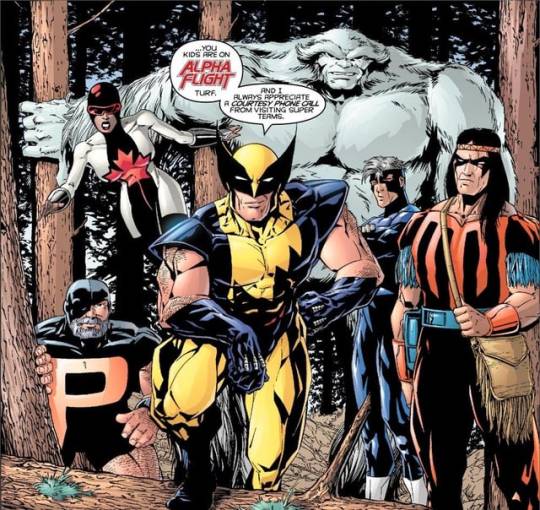
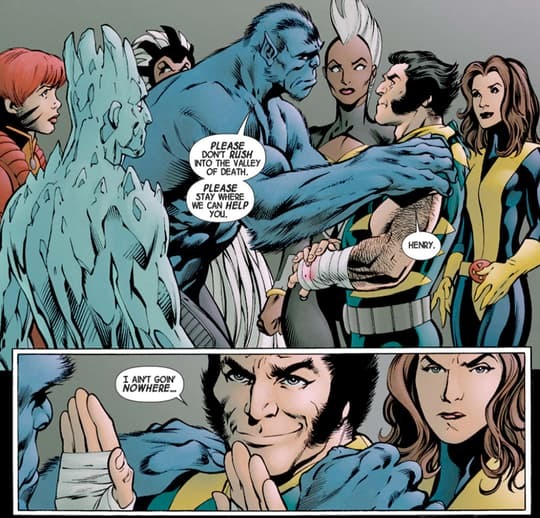
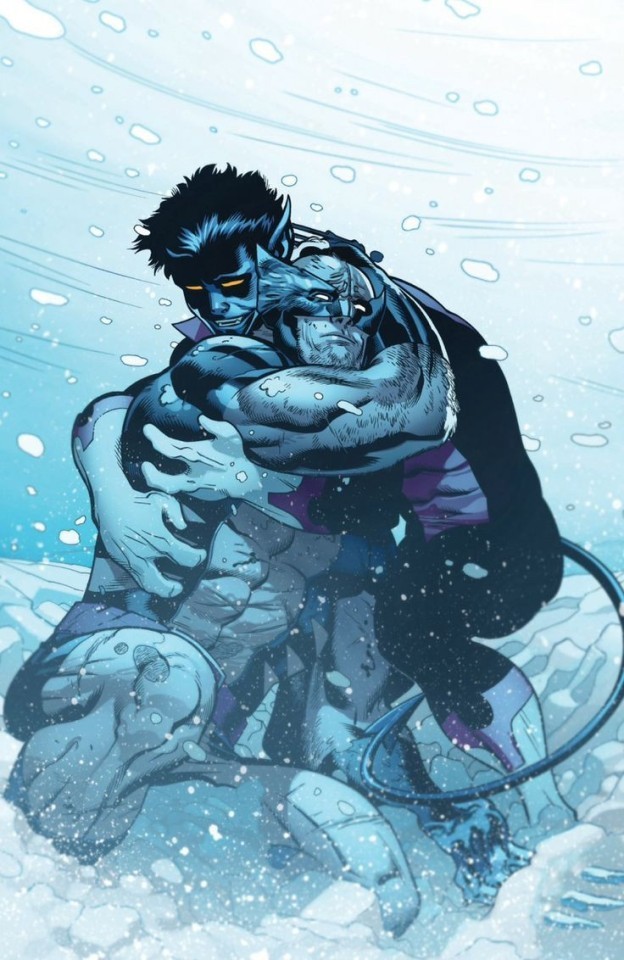
As a character, Logan was created to reflect the archetype of the cowboy/samurai with the morals of honor, integrity, and justice. He's also not afraid to be judge, jury, and executioner for the people he loves. He's a man of action.
So what is the antithetical? A man who dishonors himself by not taking his job seriously. A man who of inaction who abandons those he loves. A man who doesn't seek justice but wallows in regret and guilt.
And what did the Worst Wolverine do?

He let his fondness for drinking harm his work. While he was drinking at a bar, a group of humans invaded the X-Mansion and killed a large part of the staff, students, and X-Men. He entered a berserker rage where he murdered the invaders AND innocent people. He tarnished the legacy of the X-Men.
The title of Worst Wolverine doesn't go to the man who got brainwashed and killed without knowing. The title goes to the Logan who killed indescriminantly and didn’t want to stop.
He chose to walk away when they called out for him. He went into a beast state that made the public completely turn against the X-Men in just one night. Instead of making up for his sins, he just went to the bar again -- the very thing that killed his family. He did everything he could to go against his morals of honor, integrity, and justice.
He was a man who failed his family.
THAT'S what makes him The Worst Wolverine.
#this is a super cool convo cause im filipino american and dont know much about the blackfoot tribe cause theyre not local to my state#and i mood to culture should be shared
278 notes
·
View notes
Text
Located 62km north-east of the capital Manila, Daraitan village in Rizal province is home to about 5,700 residents, a majority of whom are members of the Dumagat-Remontado indigenous people who consider vast hectares of the mountain range as part of their ancestral domain.
But the village may soon disappear under the same waters that give it life, once the Philippine government finishes building the Kaliwa Dam – one of 16 flagship infrastructure projects of former president Rodrigo Duterte that is being funded by China.
The new dam is expected to provide Metro Manila with an additional 600 million litres of water daily once it is finished by end-2026. Officials said building the 60m-high reservoir is even more necessary now that the country is starting to feel the impact of the El Nino weather phenomenon.
But it was only in 2021 under Mr Duterte that construction finally broke ground, three years after Manila and Beijing signed the 12 billion peso (S$288 million) loan agreement.
Of the 119 on the list [of flagship projects of the "Build, Build, Build” infrastructure programme], Mr Duterte turned to China to finance 16 big-ticket projects in a bid to cement his legacy by the time his presidency ended in 2022. He embraced Beijing during his term and even downplayed Manila’s claims in the disputed South China Sea in favour of securing loans and grants from China.
Analysts have criticised Mr Duterte’s infrastructure programme as ambitious. Perennial domestic issues like local politics, right-of-way acquisition problems, lack of technology and red tape in bureaucracy led to severe delays in the projects.
The same issues hound the China-funded projects – which come under Beijing’s Belt and Road Initiative (BRI) to build infrastructure in developing nations – with the problems made more severe by Beijing’s high interest rates in its loan agreements and local backlash due to displacement of residents or potential environmental damage.
Critics say the BRI has been detrimental in the long run to some recipient countries, especially those that have been unable to repay their loans, like Sri Lanka and Zambia.
The Duterte government’s failure to take advantage of its BRI loans was a “missed opportunity” for the Philippines, said infrastructure governance specialist Jerik Cruz, a graduate research fellow at the Massachusetts Institute of Technology.
The four completed China-funded projects under Mr Duterte were controversial too. But they came to fruition because they had the support of local politicians allied with Mr Duterte and therefore increased his political capital, said Dr Camba.
Tribal leaders said they were not properly consulted regarding the project that threatens their traditional way of life. Environmentalists from the Stop Kaliwa Dam Network also say the project would destroy 126 species of flora and fauna in the Sierra Madre.
The Philippines’ Indigenous Peoples’ Rights Act states that the government must first secure a tribe’s free, prior and informed consent before building on its ancestral lands.
But Ms Clara Dullas, one of the leaders of the Dumagat-Remontado in Rizal, alleged that the Duterte government had either misinformed or pressured other tribe members into giving their consent.
She could not bear to hold grudges, though, noting that the Dumagat-Remontado organisations that eventually agreed to the Kaliwa Dam were each given 80 million pesos, or $1.9 million, in “disturbance” fees.
“The Kaliwa Dam is the reason why our tribe is divided now. There is a crack in our relationships even if we all come from the same family,” said Ms Dullas. “I can’t blame the others because we lack money. I believe there was bribery involved.”
The government requires them to present identification documents, and only those given passes may enter. Mr Dizon said this is to ensure that no unidentified personnel enter the area [close to the construction zone].
“We feel like we are foreigners in our own home because the Chinese and the people in our own government are now preventing us from entering the lands where we grew up,” said tribe leader Renato Ibanez, 48.
Mr Ibanez also accuses the Philippine authorities of harassing tribe members who are vocal against Kaliwa Dam. Some of them have been accused of working with communist rebels, a charge the tribe vehemently denies.
Unlike his predecessor, Mr Marcos is more aggressive in defending Manila’s overlapping claims with Beijing in the South China Sea, but still fosters economic ties with it.
Geopolitical tensions between the two nations and Mr Marcos’ stance towards Beijing are going to dictate the fate of the pending China-funded projects the President inherited from Mr Duterte, said Mr Cruz.
Tribe members said they would be more amenable if Mr Marcos would revisit Japan’s proposed Kaliwa Intake Weir project that Mr Duterte had set aside.
“We like Japan’s proposal. It would not destroy our forests. It would not affect residents here. The Philippines would not be buried in debt,” said Ms Dullas.
This was among the alternatives the Dumagat-Remontados offered during their nine-day march in February 2023, when some 300 members walked 150km from Quezon and Rizal all the way to Manila to protest against the Kaliwa Dam.
But they failed to secure an audience with Mr Marcos. They remain wary of the President’s position on the Kaliwa Dam and other controversial China-funded deals.
“As much as we want to fully pin our hopes on him, we don’t. We’ve learnt from past efforts to trick us, make us believe a project is about to end, only for it to be resurrected again years later,” said Ms Dullas.
2024 Mar. 3
#philippines#indigenous rights#dumagat-remontado#state violence#red tagging#infrastructure#environmental issues#afp-pnp
57 notes
·
View notes
Text
Magindara

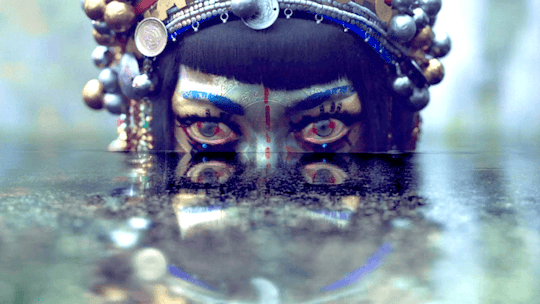
When invaders threaten your home, life, and people, you, a sirena, strike a desperate bargain with Dream of the Endless to save them all.
Dream of the Endless x mermaid!reader, one shot (for now)
Tags: war, gore, torture, death/murder, mentions of SA, slavery, things that generally come with colonialism
Inspired by the episode “Jibaro” from the Netflix show Love Death + Robots. This one shot draws heavily from Filipino mythology, culture, and history. I ENCOURAGE and INVITE people who don’t come from a Filipino background to read this story and enjoy! There is so much beauty to be had in cultures of color, for everyone. Just as I have read many stories steeped in Greek, Celtic, Norse, medieval England, etc cultures, without coming from those backgrounds, I humbly ask you do the same and entertain this little fic. Thank you. I may write a follow up if there’s interest. Glossary at the end.
-
From the banks of your river, you can hear the horses.
Metal plate clangs and screeches against itself, swords jostle in their sheaths, and shields bump where they rest on armored backs so loud that you want to scratch your sensitive ears out, just to make the sounds stop.
Your ates and kuyas hide deep below in the caverns known only to your kind. When you close your black eyes, you feel them tugging at the edges of your mind like little lights in the deep darkness of the sea. They believe that will be enough to save them.
Only you have braved the surface, because only you know what these strange men upon their strange beasts want.
They want the gold in the dark, fertile earth. You don’t understand why - it’s just shiny metal. Only the dwarves under the hills covet it. But the men who ravage your lands and your kin like wildfires, grasping everything and destroying it in the same breath, care very much. They want the never-dying orchids that line the banks and the brilliant emerald green vitality bursting from every leaf and vine that could keep a mortal alive for a thousand years. They want to feed their glory on your broken bodies. They want to take the people you protect for slaves, the women shamed and disgraced and the men subservient and humiliated.
You’ve seen it for yourself.
You’ve tasted the water of streams running red with blood, the iron like acid on your blue tongue.
You’ve swam farther and seen enough to make you hate. Families torn apart, children with their hair cut off and given names in an ugly language, forbidden to speak their own - the same language you speak. Fathers dragged onto large ships, larger than a butandíng, never to return. Altars burned. The men put your red sisters who live in the balete trees, their hair tangled with vines and lovely, fierce, flickering yellow eyes, to the flame. You witnessed their dying howls and curses for vengeance.
Some of the white-haired annani have already begun to clip their pointed ears, tear the crowns of flowers from their hair, and even cut out their tongues so as to lock away the magic these men desire, never to be spoken again. “There is no place for us,” Those tall, graceful elves told you. “We will be gone in a generation, by sword or by starvation.”
They’re coming.
The jungle is quiet as it has never been in a thousand years.
You could no more hide your tail, glittering blue and turquoise, with long, sweeping fins like ferns, than you could hide the long sweep of hair that reaches your waist, or the ink-black lines embedded on your skin, painting your face, your neck, and your arms with the story of your people and your home.
The calls that echoed from the depths of the river have stopped. It seems that your family has accepted that you won’t come back.
You look at your webbed hands, test your claws against your flesh. What is one magindara to a hundred conquistadors?
When the men spear you, they won’t just be slaughtering a mermaid. They’ll be killing the stories you keep. Centuries of stories. Countless names. Each pearl around your neck is a tribe, full of the old songs of grandmothers and the new rhymes of babies. You’re draped in thousands of shimmering strands of pearls.
You may not be the cleverest, or the most beautiful, or the one with the sweetest voice…
But you can be the bravest.
“Lord Morpheus,” You intone, frowning as the syllables ripple wrong and harsh from your throat.
You’ve never spoken to any of the gods beyond your islands before. “Dream of the Endless.” All you can do is hope and pray this one listens and comes to you in time. Will they be kind? Will it be merciful? Will he, or she, save your home?
Perhaps such a god does not exist at all, and you are praying to wind and sunlight, and soon your guts will color the cerulean water purple and black. The strange men will defile your body, no doubt. A week ago, you crawled from your river to cut down the corpse of a long-gone ate from a stake, jagged holes ripped into the tail of her corpse that made you vomit and her dead eyes full of pain.
Once you’d laid her to rest in the water, she dissolved into nothing. “Prince of Stories,” You sing. That is what faces everything you’ve ever loved if you fail.
“I beg you, save us. Save our stories, our dreams. We call for your aid.”
The men bark at each other. Any moment now, they’ll see you, your hands raised and your face tipped towards the heavens, inky flowers blooming on your forehead and cheeks and crocodile teeth tattooed on the sharp line of your jaw.
A new quiet falls over the world. Like nighttime, when things are resting, not dead.
You have called, and I answer.
A being stands on the banks of your river in the shape of a man. His hair is blacker than Bakunawa’s maw and his eyes are filled with gold and silver stars brighter than any you’ve seen before. His pale skin carries no markings.
He is as grotesquely, menacingly beautiful as the razor’s edge of shark teeth, as a great python curling in a tree, as an eagle with its claws stuck in the beating, bleeding heart of a monkey.
You feel the weight of his gaze on your brow heavier and hotter than the sun on the longest day of summer, burning out the truth in your heart. “I would bargain with you, Dream Lord. For my people, and my land, and my home, which I love more than my own life.”
What would you have me do? When Lord Morpheus speaks, his voice pours through your mind ringing like the purest, clearest freshwater.
The many jewels around your throat, pearls, sapphires, rubies, diamonds, plates of beaten gold, click as you swallow nervously.
The dream king stands so tall that he could touch the sky if he reached up. And he doesn’t look away or blink. You can’t read the inhuman planes of his face whatsoever, you can’t find any familiar sign in his long limbs that might bring comfort. For all you know, you’ve spelled your doom.
“Keep them alive. Keep our names and spirits alive. Bring our stories into your kingdom so that we won’t be forgotten. That is what the men want. They want to raze us to the ground and rebuild the world in their image but we will not go.” You pause. “We will never, ever go,” You growl, fierce and deadly, around a mouth full of fangs. In your words you pour the horrors you’ve seen, combined with the beauty surrounding the two of you.
The hot, muggy air, the warm rain, the scent of night-blooming jasmines. Orange mangoes, bursting with sweetness, bamboo sticks clacking as joyful youths dance in and out of them, laughing gaily. Rolling drums. Bright feathers tucked into black hair. A toddling child reaching out to her grandmother with a chubby-cheeked smile, pressing the back of the withered, ancient hand against her little forehead. Love, so much love.
I have not walked these lands before.
You found traces of Lord Morpheus scribbled in the margins of paper and in the back alleys of lost dreams. Your last and only hope.
When you went to Diyan Masalanta, she wept and showed how the soldiers bound her hands. When you cried out to her brother, Apolaki, the sun god called back and said the invaders took his shield.
Bathala is gone. Mayari is gone. Lakapati is dead. The conquistadors stripped her naked, cut her ribs from her chest, and planted her bones in the fields they set their slaves, your people, to work.
“They say you are Endless. You preside over all beings in all places. Please, I beg you, preside over us. Are we not worthy of your favor? Do we not deserve to live in your dreams and nightmares?”
If Lord Morpheus refuses you, you’ll cut your throat before you let your enemies have you.
He tilts his head like he can hear your thoughts. One shining hand stretches out, almost as if to touch your face. You sing prettily, little siren. You draw back with a start. Why is there hunger in his voice? A hollow, all-consuming, terrifying hunger?
You know what it feels like to starve when the fish are scarce. This is leagues away, a typhoon to your trickle of rain. Shadows bloom under his hollowed cheeks. His pupils eclipse his brilliant aquamarine irises.
He’s-
He’s aching.
Morpheus flashes his bone-white teeth as he bends at the waist to examine you further. His gaze traces your tattoos, your large, frightened eyes, and your body beneath the necklaces and bracelets.
As scared as you are, as convinced that you’ll bleed the instant his fingers brush your blue-streaked skin, your numb lips move.
“I vow to you now, Lord Morpheus, before every god and being I know, that should you render us this aid, I will give you anything within my power to grant that you wish.”
Anything?
“Name it, my lord, and it shall be yours.” With that, your eyes flutter shut as you await his judgment.
You can’t hide from him, even in your mind. You don’t see him, but you feel a straining pressure build where he prods at you, pushing on the fragile edges of your being like he’s cracking a duck egg. He claws and scrapes until-
I will aid your people.
You open for him like a sampaguita flower. Dream of the Endless picks through your soul like he’s picking blossoms, you feel how much he wants with every brush, every long moment where he sticks his fingers in and relishes the feel of you. Nothing has ever touched you like this before.
He’s on his knees on the riverbank, the dark soil pressing into his clothes. His hands clench the rocky edge of the bank. Your wet hair sticks to your back as you rise up, close enough that you can count his night-black eyelashes. There’s a dizzying amount of them.
“Thank you. Thank you. Salamat-po. And your price, majesty?”
You’ll do whatever he wants. Does his thirst demand souls? You’ll harvest them by the dozen. You can picture Lord Morpheus unhinging his jaw, swallowing those soldiers whole. Their swords wouldn’t even scrape him going down. Riches? You have no use for them if you’re dead. He can take every speck of wealth to be had.
You. I want you.
Your sisters and brothers wail. They sense the foreign king tearing at the flesh binding you together. They feel him taking a knife to your indigo heart and cutting it loose from your body. Your head tilts back as you gasp for breath and see him hold the organ aloft. Dark blood trails in rivulets down his wrists.
“I-“
There are no creatures like you in my realm. So I shall have you, in every way that I wish, and you’ll obey. Those are my terms.
Your tail lashes in the water as if you fight hard enough, you can swim away. The cavity pulses with searing, unholy pain. You’ve made a mistake. You’ve summoned- He is an aswang, a devil, a soul-eater, you’ll never see your home again, you’ll never touch the water you’ve known since birth.
Lord Morpheus brings your heart to his mouth. His lips are beautifully-formed. You can’t find it in yourself to hate such a wondrous creature. Even your amethyst ichor looks more beguiling when he’s covered in it.
It was never a question. “Yes, my lord. I accept these terms.”
His white teeth stain purple when he sinks them into your heart.
-
Glossary:
Ate (ah-tey) - sister
Kuya (koo-yah) - brother
Butandíng - whale shark
Balete tree - very cool large tree native to Southeast Asia
Annani - elves from the stories of the Ibanag people, who look like humans with pointed ears. They are kind guardians of the forest and often share healing knowledge with humans if treated with respect.
Magindara - mermaids from the folklore of the Bicolano people. Beautiful half human, half fish guardians of rivers/streams/lakes/the oceans, who sing to lure fisherman and warriors to their death but leave children unharmed.
Bakunawa - a great mythic serpent and god/goddess of darkness. Various myths place Bakunawa responsible for eclipses.
Diyan Masalanta - Tagalog goddess of love, war, childbirth
Apolaki - Tagalog god of the sun and war, patron saint of warriors, soldiers, modern day patron saint of Filipino traditional martial arts (Kali/eskrima/arnis) practitioners
Bathala - the Tagalog supreme creator god
Mayari - the Tagalog goddess of the moon, war, revolution, and justice. She fought her brother Apolaki for dominion over the heavens.
Lakapati - the Tagalog goddess of fertility, food, bounty, balance, and prosperity. She represents both male and female and has both male and female genitalia. Patron saint of queer/trans people.
Sampaguita - the Filipino name for sambac jasmine, the national flower of the Philippines
Salamat-po (sah-lah-maht poh) - thank you (utmost respect) in Tagalog
Aswang - overall name for the malicious/demonic/monstrous beings in Filipino folklore. Vampires, zombies, ghouls, organ eaters, cannibals.
I hope you guys liked this! Let me know if you have any questions or want to read more from this.
#the sandman#magindara#sandman#the sandman comics#sandman comics#the sandman tv show#sandman tv show#dream of the endless x reader#dream of the endless x you#Dream of the endless#lord morpheus#lord morpheus x reader#lord morpheus x you#Morpheus#morpheus x you#morpheus x reader
243 notes
·
View notes
Text
i get sum level of freedom since im creating an entirely new island + native cultures within it but it also means i gotta figure out all its details..........
lil update !!! i am in fact still working on my fic !!!!!!! i've simply been doing lots & lots of research bc many snippets, specifically those abt kehlani's early life, will be set in the philippines and i wanna learn all i can 🫶🫶🫶
#worst part??#im putting so much thought into a fictional culture which'll only have so little actually shown in the fic.......#luckily enough !#reading abt a bunch of indigenous filipino tribes for inspo is super interesting <33
7 notes
·
View notes
Note
Hii! Any filipino alternative artist/band recommendations?
omggg haiii thank u for asking me i luv talking abt filipino alt artists 💗 gonna put artists/bands + the songs i luv from them so sorry for the long reply :c
Slapshock (THE filipino metal band)
Bandera
Anino Mo
Cariño Brutal
Datu’s Tribe
Apiculture
Karne
Dicta Lisence
Diktador
Ang Ating Araw
yk what their entire Pagbigkas album
Sugat
Criminal
Ode to Laluna (underrated FAV!) (all women band)
Kadiliman
Sayaw
Sa Ilalim ng Lupa
Chelsea Alley
Vis
Anhura
The Voyager
Panagpo
Dead People
Slaughtered by Vengeance
Greyhoundz
Krus
Battle Cry
XXV (ft. Gloc 9)
Queso
Parusa
Insekta
Wolfgang
Halik ni Hudas
Mata ng Diyos
Valley of Chrome
Dagat ng Apoy
Pagbangon
entire ‘Valley of Chrome’ album tbh
Phillia (female vocalist)
Killers
Condemned
PSYWAR Philippines
Heneral
IMORTAL
Mildskill (from laguna😩✨)
Delusyon
Huling Alas
Kjwan
Sa Ilalim
One Look
Death by Stereo
Suwapang
Maynila
a lot of these bands only came to be in the early 2010’s so there aren’t quite many albums/songs for many of them! but i hope u find a band u like bc dhbdhshs i luv all of them soooo much esp ode to laluna and dicta lisence
also a lot of these bands tend to have diff subgenres w every album lol. a big theme is hiphop influences esp with the metal ones
#IM SO JEALOUS OVER THE PEOPLE IN VISAYAS U GUYS ARW WITHIN HALF THESE BANDS’ VICINITY#cries in rural luzon#RURAL CENTRAL LUZON😭😭😭😭#if u want…. i have an oc who’s playlist is mostly filipino metal…..#i could listen to ode to laluna and dicta lisence forever and not get tired#opm#music recs#filipino music
8 notes
·
View notes
Text

[ID: A header of Kai leaning into Mr. Chidouin's embrace as he smokes. They are sitting on a porch against a sunset background. END ID.]
⊱ JESTER /TOBIAS — 20 ⊹ SE/HIR ⊹ FILIPINO ⊹ ARTIST/WRITER
— TRANS WOMEN OF COLOR COLLECTIVE — DOCTORS WITHOUT BORDERS — WORLD CENTRAL KITCHEN
hello, hello! ( ´ ∀ `)ノ the name's jester - or tobias! i adore coulro of all sorts, pandas, dragons, and have longstanding interests in technology soft/hardware, criminal organizations, as well as asian culture, history, and language!
alongside eng, i understand fil/esp well enough & am always down for media recs! i'm currently learning japanese as well; though i am much less fluent, the same offer applies even if there's no translation! so don't worry 🫶
speaking of, i appreciate every single comment/ask/etc. - i love getting the chance to interact w you all, even if it takes me a bit longer to get to them these days <3

[ID: A Hollow Knight divider separating the text. END ID.]
⊱ ART — FARESONG ⊱ WRITING — DATASTATE ⊱ DISCORD — DATASTATE & [YTTD SERVER]
CURRENT FIXATION: YOUR TURN TO DIE CURRENTLY PLAYING: JUDGEMENT (RGG) CURRENTLY READING: NABARI NO OU
▸ HOLLOW KNIGHT — dreamers & companions, five knights, thk, moth tribe, mask maker
▸ YTTD — asunaro (kai & michiru), satous & chidouins, yabusames, kizuchis
▸ YAKUZA — haruka sawamura & daigo dojima, saki nakahara, lihua & xiaoqiao, goro majima
▸ NINTENDO — tribes of darkness & ancients (spm), doopliss & vivian (ttyd), nastasia & mimi (spm), pixl queen (spm)
▸ APOTHECARY DIARIES — maomao, aduo & fengming, lishu, loulan, gaoshun
▸ MISC — susie, queen, seam & jevil (deltarune); amaterasu (ōkami); clover & snake (999); sirius gibson & claire elford (witch's heart); feys & godot (ace attorney); ryuzaki (death note)

[ID: A gif of a small, plush panda spinning around. END ID.]
▸ last updated: feb 25, 2025◂
#if there are any link issues please let me know d( ̄~ ̄ )#jestersvaguely#my art#hk posting#yttdposting#yttd meta#yttd hcs#ykza tag#for me#insp#cat tag
13 notes
·
View notes
Text
SO. THAT NEW EPISODE HUH
(blah blah blah, reaction’s under the cut. Y’know this already)
• THE FUCK IS THAT THUMBNAIL. THIS IS LIKE THE 5TH DC THUMBNAIL TO HAVE TWO GUYS KISSING EACH OTHER IF YA INCLUDE THE TOMJAKE SPINOFF
• OFC THE SCENE WHERE DEREK’S APPLAUDS TREVOR DURING THE CHALLENGE DEMO PLAYS OVER HIM TALKING ABOUT LAST EPISODE’S CHALLENGE
• STOP REMINDING ME THAT ALESSIO’S FUCKING GONE
• WAIT DON’T PLAY THE INTRO, HE’S LITERALLY THE FIRST CONTESTANT WE SEE IN IT
• “Look poker’s very skilled based, but I’m realizing i need to play with more poignancy” Bro idk what the actual fuck you do to play poker, so I can see where he’s probably coming from
• Idk if Lynda sounds like she’s lying or not, but I immediately got blindsided over Ted mentioning his wife AND son. Fucking plot twist right there lmao
• There’s smth pretty sweet about Ted & Lynda bonding about their kids going through puberty lmao
• Uh oh new alliance droppped
• GET HER ASS ANASTASIA. PICK ON HER BITCHASS FOR DECIDING TO ELIMINATE ALESSIO
• “Ted told me Alessio was bringing the boys together. He was a quiet mastermind.” BULLSHIT
• MF HE WAS ONLY HERE TO GET ARTISTIC ENLIGHTENMENT. KEEP MY KIN’S NAME OUT YOUR FUCKING MOUTH
• Isabel’s being sillyyyy- WAIT LOGAN’S STARING AT ONE OF ALESSIO’S PAINTINGS WITH A SAD FACE. YOU CAN’T MAKE THIS SHIT UP
• “Got a thing for fine-wine italians?” LMAO NATALIA
• AWWW LOGAN’S DEFENDING ALESSIO
• “Logan’s a sweet kid” Damn right
• WAIT THEY ACTUALLY SAID THE WORD. NATALIA MENTIONED HER BEING TRANS STRAIGHT UP HELL YEA
• Caught in 4K lol
• Oooooo Amelie’s getting suspicions
• Ofc Jade tells Spencer about her idol hint. Hmmmm, she doesn’t mention how she ACTUALLY got it tho…
• What kind of distraction does Jade want Spence to make?
• Benji’s eepy
• “It’s for the game” I KNOW WHERE THIS IS FUCKING GOINGGGGGGG
• NO WAY HE’S TRYING TO FLIRT WITH HIM
• Bro’s rizz is worse than a certain bald cubito I know
• Pretty nice Diencer crumbs tho. I saw someone call them “studyguide” & I think that’s an AMAZING ship name. I’m using that for them from here on out >:D
• YEA SHE GOT THE IDOL!
• Aw her backstory ;-;
• She got picked on for her skin condition, but her moms were still supportive of her :’D
• YEA JADE YOU GO GIRL. FOLLOW YOUR DREAMS
• Group yoga :D
• YEA VIBE TRIBE TRIO BONDING. I LOVE THEM
• Love me some Zaivy crumbs. There’s gotta be a cool ship name out there that mixes culinary & performing arts together
• “I have Spencer on my radar. Him and Diego are getting tight” YEA I CAN SEE WHERE YOU’RE COMING FROM IVY >:3
• HANNAH ILY. But yea Diego’s kinda right, y’all better not get cocky
• “Haha, cock” I felt this with my soul. Especially everyone getting weirded by Benji saying this. IT’S THE GIVING HEAD THING FROM EP 1 ALL OVER AGAIN
• “Running into traffic would be safer than having you as a lawyer.” HOLY SHIT SHE FUCKING KILLED YOU DUDE
• BENJI’S A FUCKING DORK. I LOVE HIM
• “I want to win to win this show. So I can quit law, and start a new life. Maybe figure out actual goals for myself.” BRO I’M ROOTING FOR SO MANY PEOPLE IN THIS SHOW WTF. LIKE AT FIRST, I WAS JUST ROOTING FOR TRISTAN & HANNAH BECAUSE I COULD SEE A PART OF MYSELF IN THEM AS A NON-BINARY FILIPINO-CANADIAN, BUT BASICALLY EVERYONE IS SO INTRIGUING IN A WAY. AND THIS INCLUDES ALESSIO
• Why was everyone expecting Alessio getting the boot- WAIT DON’T SAY THAT IN FRONT OF LOGAN HE’S GETTING SAD
• “M’lady.” DEREK HELPING UP TREVOR ONTO THE TRAIN CART???? AND THEN THEY HAVE FUCKING SPARKLES IN THEIR EYES??? I NEED TO BE SEDATED
• Ooo truth or dare challenge involving the contestants’ fears? Does that mean Logan has some internalized homophobia considering the thumbnail?
• Oh damn, Emily looks like she’ll have fun giving out the truths & dares
• Why would Amelie be up in arms about reading- oh wait there’s bad reviews on that paper, that makes sense
• “Marissa! Answer this; rank your team from most valuable to least” Lemme guess, Anastasia’s the most valuable on her list
• ANASTASIA ENCOURAGING HER TO DO SO IS PROVING MY POINT
• Ooooo they peeking :> Tristan’s face look rlly cute :D
• Yeah I can see why her team’s laughing at the insults from her bad reviews
• Marissa opting out of ranking her teammates honestly makes sense when she wants her team to be unified in some kind of way
• Lynda shut the fuck up.
• SEE NATALIA AGREES WITH ME- and ofc Ted’s siding with Lynda after the convo we saw between them
• YEA MORE ANARISSA CRUMBS >:D
• “I believe in english you refer to that as a… meatrider!” LMAOOOOO YEA
• Oh nice they’re besties now!
• wait this reminds me of something…
• TWO STARS? HANNAH DESERVES 5 WHAT ARE YOU TALKING ABOUT
• “Describe the worst dish you ever made” Zaid it can’t be that bad bro, what’s with the shocked face
• “Bro, you’re like… you’re like Gordon Ramsay! Who cares if ya made an undercooked steak once, y’know? C’mon just tell her!” YEA TRISTAN! >:D
• Oh yeah, it can be that bad. Who the fuck cooks KOALA
• DIEGO’S HOLDING ONTO SPENCER
• Also, plz don’t puke again bro
• Oh so it was for money, and he didn’t know he was gonna cook that. AIght makes sense
• “Tell that to PETA” LMAOOOOO
• DIEGO’S STILL HOLDING ONTO SPECNER WHILE THEY’RE LEAVING THE TRAIN CART
• Richard, you only have two strands of hair on your head, it’ll be fineeee
• See? He accepted it- wait nvm
• BRO WE CANNOT TELL IF YA SHAVED YOUR HEAD WITH YOUR HAT ON. RELAX
• Oh noooo, Ivy had to eat a worm. At least Zaid’s there to comfort her
• It’s just a cold bath, why’s Ted scared of that- anddd he’s uhh… is he dead
• LOGAN’S FIREMAN CARRYING HIS BODY LMAO
• Ngl I used to be scared of dogs when I was a toddler I can see where Lynda’s coming from
• WAIT BENJI’S JOTARO COSPLAY LOOKS AWESOME. WHY IS EVERYONE LAUGHING AT HIM OVER THAT
• Aw, Tristan’s there to comfort Benji :D
• I feel like I could solve the math question Jade got. Proud that she got it right! :D
• NAT HAS TO DO PUSHUPS OVER A BUNCH OF FUCKING MOUSE TRAPS?!
• Aw, Isabel’s praying for her :D
• “It’s just one question. How hard can it be.” I can see Apollo’s gift of prophecy hitting her like a dodgeball
• told ya. Then again, I am kinda intrigued about how Isabel converted to catholicism after she mentioned her parents weren’t catholic
• YOU GOT THIS TRISTAN!
• “I’m feeling left out. Ted got an ice bath, and Benji got to show off some dope cosplays! Where’s my moment in the spotlight, ya know?” I LOVE HOW TRISTAN’S ANIMATION LOOKS SO BOUNCY DURING THIS. THEY LOOK SO CONFIDENT & HAPPY
• “Sorry to interrupt!” I JUST WANNA SEE TRISTAN MAN WTF
• Also fun fact, apparently the guy encouraging you to support ONC is actually Connor’s VA! Small world, huh?
• Either way, please go support Disventure Camp, and ONC at large. This whole Toon Boom thing really hit them hard, but any kind of support will help them out!
• Tristan has to punch someone in the face? What’s wrong with that?
• Oh yeah that’s right, Tristan’s here for a good time and thinks being friends with others’ll help them get further in the game. I still like going back to their audition tape from time to time :>
• “Uh… how hard?” “Strong enough to hurt! Weak enough to not cause a lawsuit.” LMAOOOOOO
• Zaid volunteers as tribute
• Makes sense since they were upset about the koala taco thing
• Ivy cheering Tristan to deck Zaid in the face reminds me on this one “YES SONIC! SPLIT IT WIDE OPEN!” comment I saw in a Sonic Frontiers vid. The vid was basically just the song that played when you fought the Knight boss (dope song btw, It’s called “Find Your Flame”)
• OH DAMN, BRO’S IN A FIGHTING STANCE & EVERYTHING- they missed Zaid’s face and punched his chest instead
• Part of me isn’t surprised considering how their fight with Richard went last episode
• “Pretend I’m your worst enemy.” “I ain’t got one of those!” Mood
• I didn’t know why Tristan got upset over Zaid calling them Marilyn Manson, but one google search later, and yeah I can see why Tristan decked him in the face
• Tristan’s so sweet i love them :D They immediately apologized to Zaid after punching him
• TRISTAN BACKSTORY HELL YEA
• “The world keeps spinning regardless if you’re frowning or smiling, so I guess I choose to keep smiling.” PRECH IT TRISTAN ILY. WE HAVE THE EXACT SAME MINDSET
• Wait we don’t hear Isabel’s entire backstory? Just the end of it? damnit >:|
• NAH DIEGO HAS TO FIGHT A CHICKEN- wait was that the fucking minecraft chicken sound effect
• “Go! Diego, go!” that has to be an intentional reference
• AW SPENCER’S NONVERBALLY CHEERING FOR HIM :D
• DAMN HE’S GETTING CLOCKED BY THAT CHICKEN
• Richard stop saying that “it’s just hair” when you’re bitchass was sobbing over losing two fucking strands from your head
• Ngl Anastasia’s design is really growing on me. No wonder Marissa called her pretty :>
• Also her whole “Men only see me for my looks” thing is not helping her beat the lesbian allegations
• Oh shit, why’s Spencer afraid to talk about his previous relationship. WHY’S HE LYING????????
• BRO DIEGO COMFORTING AND TELLING HIM TO HOLD ONTO HIM HAS GOTTA BE A PARALLEL TO DIEGO HOLDING ONTO SPENCER DURING EPISODE 1’S ROLLER COASTER CHALLENGE
• “Your dare is… to kiss a model we brought backstage.” Oh…. OH
• “Helloooo gorgeous- A DUDE! THAT’S A DUDE!” Is this internalized homophobia? (plz picture the “is that a pigeon” meme while ur reading this. I might look kinda rude-)
• “Just picture he’s Alessio!” LMAOOOOOO
• Oh damn he’s enjoying that- BITCH THE FOOTPOP??
• Blue team walking into a Trevek shoulder grasp lmao
• “This kiss was fine I guess…” I KNOW WHAT YOU ARE
• Oh I am DREADING this elimination. EVERYONE IN IT IS LIKEABLE AND/OR INTRIGUING. ESPECIALLY TRISTAN & HANNAH
• “Hannah’s been really helpful with mending bridges. It’s… not an awful idea listening to her.” DAMN RIGHT! >:D
• Yeah Jade’s suspicious about Amelie.
• Oh damn, trios & groups are being set in stone in red team; there’s Diego, Jade, & Spencer, the vibe tribe, and Hannah, Amelie, & Benji by the looks of it
• DIEGO CALLED HIM “SPENCE”. THEY’RE ON A NICKNAME BASIS
• SHOULDER GRASP. WE GOT ANOTHER STUDYGUIDE SHOULDER GRASP
• Oh shit we got some TENSION
• Hannah listening in on Tristan wanting to vote out Amelie. Call that tristannah crumbs (I’m getting delusional atp)
• SPENCER OR AMELIE MIGHT GET OUT?! WTF I LIKE BOTH OF THEM
• At least it’s not Benji ig. HE SURVIVES TO LIVE ANOTHER DAY! WHO CHEERED
• “Why was I not consulted by Spencer? Am I that lame?” Bro did you forget what happened during the challenge. he was LAUGHING at your cosplays
• Aw, Hannah’s upset ;-; but her putting her head in her hands reminds me of that shinji chair meme lmao
• HANNAH TALKED TO TRISTAN OFF-SCREEN LET’S GOOOOO
• Oh shit, the votes are in vibe tribe’s hands
• Trevek’s rubbing off of each other. I LOVE IT
• Tristan pondering their vote by tapping the pen on their head honestly feels in character
• Oh god, I think I know where this is going…
• BENJI GOT DISTRACTED BY A FLY AGAIN LMAO
• …
• I mean… they probably want to continue the studyguide plotline, and Amelie did paint a target on her back by being a dick. So… yeah, I’m not that surprised over her elimination
• this is an actually heartfelt goodbye- WAIT TREVEK’S JUST LOOKING AT HER WITH BLANK ASS EXPRESSIONS LMAO
• “Thank you all… for being good teammates. I know I was harsh with some of you, but… that was only because I wanted us to win. Hope it’s not personal.” ONC’S FUCKING ME UP TWO ELIMINATIONS IN A ROW. I DIDN’T ASK FOR SEVERE EMOTIONAL PAIN
• AW HANNAH WENT IN TO HUG HER
• Oh shit, she left with a sad look on her face. That honestly hits different when ya remember that Alessio left with a smile
• So yeah, all in all, pretty great episode! Shipping crumbs were great as always (especially for studyguide :>), it’s nice to see Logan… well… y’know, and NOW I’M SAD OVER TWO ELIMINATIONS-
8 notes
·
View notes
Text


Spend weeks getting inked at Buscalan Tattoo Village in Tinglayan Kalinga.
Home to the butbut tribe and the world famous Apo Whang-Od (or Fang-Od), the last mambabatok. Before, "Batok" [the traditional hand-tapped Filipino tattoo] is primarily given to headhunters as a symbol of honor for protecting villages or for killing enemies. Given that headhunting and tribe wars are just stories of the past, this sacred art of tattooing has now become part of Buscalan's various attractions.
Prior to my trip, I made prior arrangements with a local guide in Buscalan. I've been planning for so long to get an arm sleeve tattoo etched on my skin made by her apprentices and the signature 3 dots from Apo Whang Od. It is something that I considered as a legendary trademark and not everybody will have the opportunity to be tattooed by her. She is a 106 years old already. Time is flying. I need to get that tattoo. So the moment I felt that rush, I immediately but carefully planned a trip there.
29 notes
·
View notes